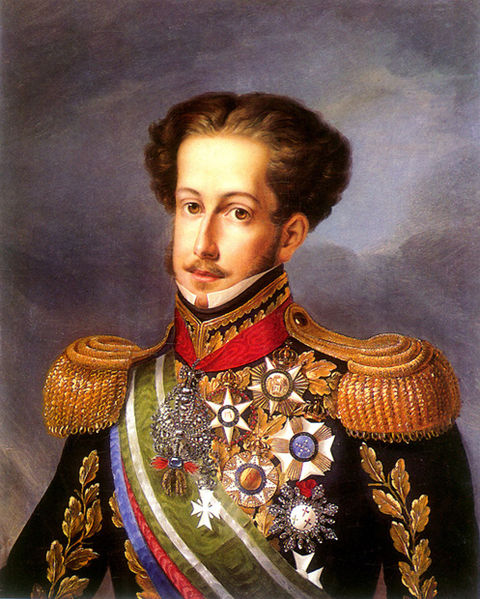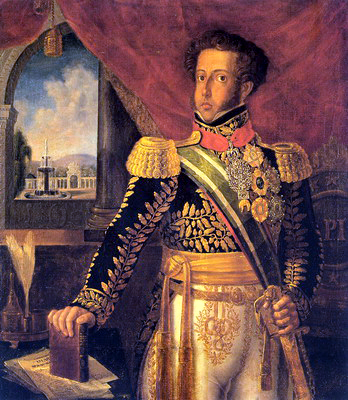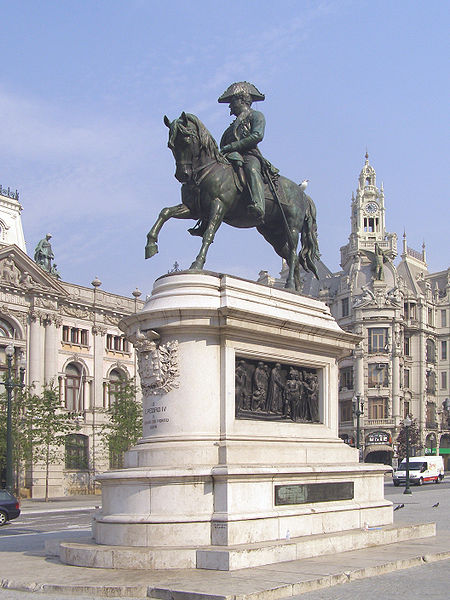<Back to Index>
- Chemist Christian Gottlob Gmelin, 1792
- Soprano Gilda dalla Rizza, 1892
- Emperor of Brazil Pedro I, 1798
PAGE SPONSOR
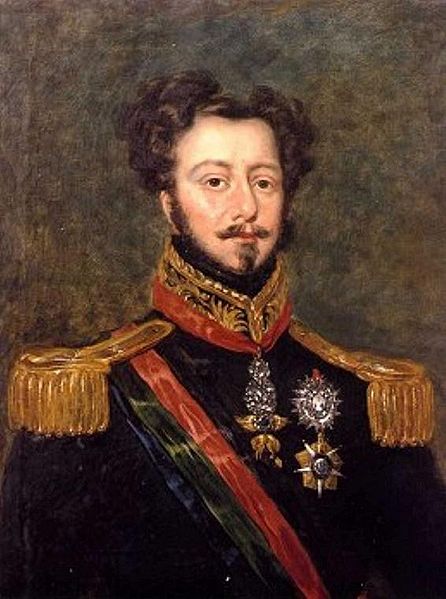
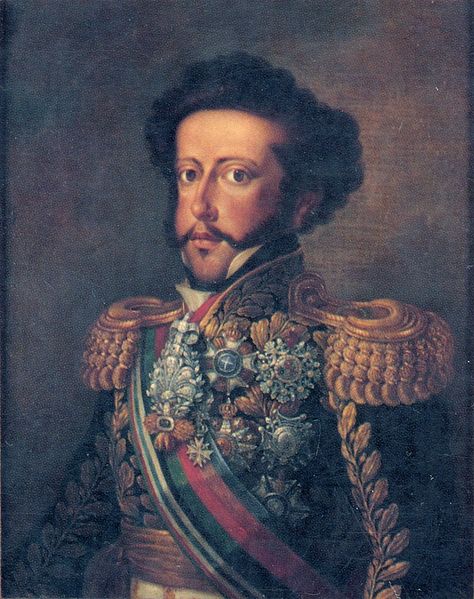
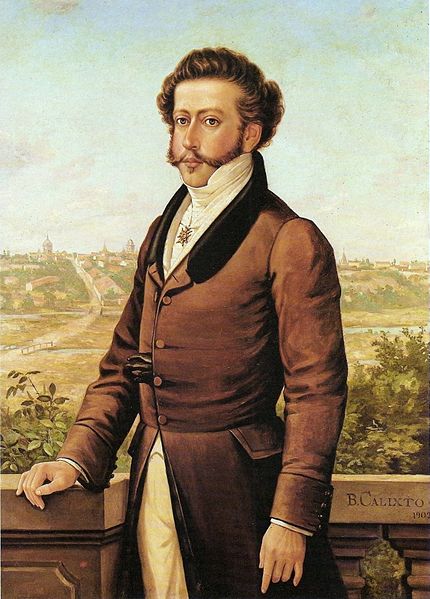
Pedro I of Brazil (October 12, 1798 – September 24, 1834), was the founder and first ruler of the Empire of Brazil and also King of Portugal as Pedro IV, having reigned for 8 years in Brazil and 2 months in Portugal, respectively. His full name was Pedro de Alcântara Francisco António João Carlos Xavier de Paula Miguel Rafael Joaquim José Gonzaga Pascoal Cipriano Serafim. He was born on 12 October 1798, in Queluz, the fourth child of King John VI of Portugal and Infanta Charlotte of Spain. The Emperor - King was a member of the Portuguese branch and founder of the Brazilian branch of the House of Braganza and was referred to using the honorific "Dom".
Pedro was born on 12 October 1798 at the Queluz National Palace, near Lisbon. His father was the prince regent at the time and would later become King John VI of Portugal (João VI); his mother was Charlotte of Spain (Carlota Joaquina), daughter of Charles IV of Spain; he was the royal couple's second child. When his elder brother the Infante (Prince) António Francisco died in 1801, Pedro was made Prince of Beira as he was the heir-apparent of the then Prince of Brazil, his father. In 1807, when Pedro was nine, the royal family left Portugal as an invading French Army approached Lisbon (Napoleonic Wars). They arrived in Brazil with an English escort in early 1808. The family would remain in the country for 13 years. Their presence made Rio de Janeiro the de facto capital of the Portuguese Empire, and led to Brazil's elevation to the status of a kingdom co-equal with Portugal.
It is said that Pedro was John VI's favorite son, although the same could not be said about Carlota, who cherished her second son Miguel. The education of Pedro I was very much neglected. Both Pedro and his brother Miguel were brought up haphazardly. Pedro and Miguel would often run away from their tutors to mingle with stable boys and spent their days running around the streets with uneducated children. This led the boys to pick up habits that may have been considered uncouth by some of their contemporaries, and the colloquialisms of the so-called plebeian classes. As a result of his familiarity with street life, Pedro grew up with little respect for the symbols and conventions of his age. Because of this, he felt himself to be the son of the people rather than the son of royalty. All his life he would become familiar with individuals in every different aspect of life.
Pedro adapted well to the Brazilian milieu. He was an excellent horseman, enjoyed the military life, and could compete with common soldiers and officers equally. Also, he demonstrated early musical talents and later composed some music of creditable amateur quality. Besides music, he displayed a knack for drawing, sculpting, the manual crafts, and even poetry. He was considered to be handsome, and was soon to be the talk of the town. Riding on horseback, he would often be bold enough to draw back the curtains of passing coaches, in search of beautiful women. His young endeavors with these women would give him a bad reputation that he would not be able to shed in the future.
In 1817, Pedro married Archduchess Maria Leopoldina of Austria, a daughter of Francis II, Holy Roman Emperor. Although she married him for imperial reasons, she loved her husband even if it wasn’t reciprocal. Throughout Pedro’s difficult days, she proved to be a devoted collaborator. Leopoldina’s intelligence, consideration, and personality quickly earned her the respect and admiration of the Portuguese and Brazilians, as well as of her husband, but she was unable to distract him from his amorous affairs. Leopoldina lacked many of the feminine traits, which appealed to Pedro. She was very modest in her appearance and had little interest in personal adornment. As she began to get to know the Brazilians better and understand their noble qualities of freedom and independence, she started to love the Brazilians and considered herself as being one.
John VI returned to Lisbon in 1821 after the defeat of Napoleon. He did not leave empty handed, however; he took from Rio de Janeiro to Portugal all the money in the treasury, leaving his son Prince Pedro as regent in Rio. At the time, the Brazilian elites were scared of recolonization and the loss of control over the provinces. Inspired by the newly won independence of Spain's former South American colonies, Brazilian patriotism and nationalist sentiment grew among Brazil's elites. Observing what was happening in the New World, John VI advised Pedro to declare Brazil independent and take the throne for himself rather than allow a usurper to take over the country. This way there would still be a Portuguese king in power in Brazil. By the year’s end, Pedro had officially declared Brazil an independent constitutional monarchy with himself as monarch.
When John VI finally returned to Portugal, in the early 1820s, most of the privileges that had been accorded to Brazil were rescinded, sparking the ire of local nationalists. Pedro, who had remained in the country as regent, sided with the nationalist element and even supported the Portuguese Constitutionalist movement that led to the revolt in Porto in 1820. When pressed by the Portuguese court to return, he refused. Pedro's official declaration of permanence on January 9, 1822 is known today in Brazil as the Dia do Fico (I Will Remain Day). For that, he was demoted from regent to a mere representative of the Lisbon court in Brazil. This news reached him on 7 September 1822, when he had just arrived in São Paulo, from a visit to the port of Santos. On the banks of the Ipiranga River, he unsheathed his sword, removed the blue and white Portuguese shield from his coat, and declared "Independence or death!" This later became his famous speech O grito do Ipiranga (The Cry of Ipiranga). He was proclaimed Emperor of Brazil on 12 October his 24th birthday, and crowned on December 1.
The early years of Brazilian independence were difficult. Dom Pedro I assumed the title of Emperor instead of King to underline the diversity of the Brazilian provinces, The Napoleonic concept of Empire as a more modern and progressive form of monarchy embodying rejection of the Ancien Régime also
was useful in uniting the relatively cosmopolitan society of Rio de
Janeiro with the more conservative, patriarchal stance held in the rest
of the country. In
early 1823, the first problem confronting Pedro I was drafting a
constitution. Brazil was divided between the Brazilian Party led by
José Bonifácio, which included the landed aristocracy who
favored a constitutional monarchy, and the Portuguese party which
included the commercial class, office holders and families of recent
Portuguese origin, who wanted an absolutist monarchy. In 1822, during
the struggle for independence, Dom Pedro I had considered himself a
liberal and had promised Brazil a constitution. He soon appeared to
forget his liberal ideals by enacting a Constitution that gave him
substantial power. This was seen as necessary to keep control of the
interior, particularly in the feudal North, and to prevent the
instability and democratic fractioning that characterized other areas
of Latin America during this time. The Brazilian party dominated the
assembly and refused to assent to so much power in the hands of the
emperor. Conflict increased further after Muniz Tavares, a Brazilian
assemblyman, attacked the Portuguese party, which he believed resented
Brazilian independence. The Sentinella and the Tamoyo, two
constitutionalist papers, were written to attack Portuguese born
officials. In response to the dispute, Dom Pedro dissolved the assembly
on 12 November 1823. He exiled many assemblymen and jailed a few.
Upholding his promise to provide a constitution, he then gathered a
committee of ten who then ratified a new, but very similar,
constitution on 25 March 1824. This rewritten constitution remained in
effect until the end of the Brazilian empire in 1889. The
new constitution established a conservative, centralized monarchy with
significant constitutional limitations and power sharing. It sought to
maintain stability and protect property. Powers were divided into
executive, legislative, judiciary, and moderating branches. The legislative branch contained the Senate and the Chamber of Deputies,
both of whose members were elected to power. Unlike the Chamber of
Deputies, the Senate remained in office for life. The Council of State,
or the judicial branch, consisted of a council of respected elders whom
the emperor appointed for life and who exercised executive powers to
issue judgments in important issues, such as war. The emperor held
supremacy or moderating power. He could therefore veto all resolutions.
He was also empowered to appoint a senator from a group of elected
senators, appoint councils of state, pardon criminals, review judicial
decisions, and replace elected deputies, presidents of provinces,
ministers, bishops and senators. Pedro’s failure to put the
constitution in effect immediately, however, left many Brazilians
suspicious that Pedro's support of a constitution was a ruse. During
1824 and 1825, many Brazilians became opposed to the accumulated powers
of the emperor and the unpopular provincial presidents he appointed.
Secret opposition papers attacked the emperor, his ministers, his
servants and his mistresses, in particular Domitilla de Castro, the
Marchioness of Santos. Dissatisfaction climaxed with the revolt of
liberal urban forces in Pernambuco. Friar Joaquim do Amor Divino (popularly
known as "Frei Caneca") led a revolt in response to the appointment of
an unpopular governor, Francisco Paes Barreto. In July 1824, Frei
Caneca and Manuel de Carvalho sought to unite several republics in the
formation of the Confederation of the Equator. The Confederation failed to take hold and the emperor put many revolutionaries to death, including Frei Caneca. The
absolutist character of events in Rio raised concern in the mostly
liberal Northeast. This region soon called for its own constituent
assembly. But the movement was not a success because it was divided
within itself on the issue of slavery and because Dom Pedro hired
British and French ships and mercenaries to repress them. Because of
this, Britain was able to underwrite much of the transition to
Brazilian independence. Britain could also facilitate recognition from
the international community, and Dom Pedro sought this recognition of
Brazil’s independence. At first European nations were reluctant because
of the hesitance of Portugal. The United States became the first to
recognize its independence. By 1825 Britain, realizing the importance
of Brazil’s market, convinced Portugal to accept Brazil’s independence.
In exchange, Pedro agreed to repay a loan from Britain for the war
between Portugal and Brazil. The loan implied that Pedro would inherit
the Portuguese throne. He also signed a treaty with Britain, continuing
the 15% import tariff and abolishing the slave trade within three
years. The concessions to end slavery especially made Pedro I unpopular
with the landed aristocracy, which constituted much of the Brazilian
party. Republican sentiment soared, and during the 1825 war with Argentina, the Cisplatine province seceded to become Uruguay.
The war lasted for two years, and as a result Brazil suffered great
military and financial devastation. When Pedro visited the troops in
November 1826, the beloved empress Leopoldina died. Pamphlets were
published accusing Dom Pedro of imposing physical violence on her
during her pregnancy, while having an affair with Domitilla. On
the death of his father, Pedro inherited his title as King of Portugal
(Pedro IV) on March 10, 1826. He promulgated the Portuguese liberal constitution of 26 April, but abdicated the throne of Portugal on 28 May 1826 in favor of his daughter Maria II. Since she was then only 7 years old, he nominated his brother Dom Miguel as
regent, on the promise that he would marry her. Dom Miguel, however,
deposed Maria, and Pedro spent the next years engineering her
restoration. Meanwhile, his apparent indecision between Brazil and
Portugal further damaged his waning popularity in Brazil. On 17 October 1829, Pedro married his second wife, Princess Amélie de Beauharnais von Leuchtenberg, in Rio de Janeiro. Amélie was the daughter of Eugène de Beauharnais, and the granddaughter of the Empress Josephine. She was also the sister of Charles Auguste Eugène Napoléon de Beauharnais, who married Maria II once her marriage to Dom Miguel had been annulled. Domestically,
Pedro was accused of mismanaging financial affairs. During his reign,
debt rose, inflation grew, the exchange rate sank, and the bank issued
ineffective paper money which drove gold and silver out of circulation.
The cost of living rose in the cities. British tariffs also troubled
the elite and middle class, who demanded imported consumer goods. The
production of tobacco, leather, cocoa, cotton, and even coffee
declined. With the Portuguese still in control of most of the retail
market, anti-Portuguese feelings mounted. The cumulative result of
military, domestic and economic setbacks prompted most of the urban
elite, who had been absolutists, to side with the liberals. Even the
army, discontented with Portuguese commanders and military defeats,
distanced itself from the emperor. In the end, Dom Pedro's aspirations in Portugal cost him his rule in Brazil. In
the aftermath of a political crisis that followed the dismissal of his
ministers, and amid a growing economic crisis, Pedro abdicated his
throne in Brazil in favor of his son Pedro II on 7 April 1831, who was only five at the time. Pedro reasserted his use of his old title, 18th Duke of Braganza. With
the death of João VI on 10 March 1826, Pedro, as the rightful
heir, briefly inherited as Pedro IV of Portugal. During his reign, on
29 April 1826, King Pedro IV issued, from Rio de Janeiro, a new Constitutional charter to
the Kingdom of Portugal. This Constitution confirmed the exclusion of
Pedro's Brazilian heir, Imperial Prince Pedro, from the Portuguese
Succession, by establishing that the Portuguese crown would be
inherited by Princess Maria da Glória. The language of the
Constitutional Charter, in speaking of a "cession of right", already
announced the abdication that was to come. On 28 May 1826 Pedro
abdicated the Portuguese throne to his seven year old daughter Maria da
Gloria, who became Queen Maria II of Portugal. However there was a key
condition, that, when she became of age (14 years), she would marry
Pedro's brother Miguel. Pedro's sister, Isabel Maria,
became Regent. Miguel accepted this solution and distanced himself from
the absolutists, some of whom staged a rebellion, failed, and fled to
Spain. In
1827, Miguel attempted to put a claim on the Regency over Isabel Maria,
although nobody accepted the suggestion out of fear of the absolutists.
On 22 February 1828, Miguel returned to Portugal, and four days later
he took the oath to his brother and the charter and was installed as
lieutenant - general. This loyalty did not last long. Miguel and his
mother, Carlota Joaquina, immediately began to oust the liberals and
demonstrations in favor of Pedro or the constitution were prohibited. A group of exiled liberals landed at Porto from the British ship, the Belfast, and raised a rebellion. The rebellion failed and the senior liberals were forced to take refuge back on the Belfast, and leave again for England. Of all of Portuguese territory, only the Azores remained faithful to Pedro, partly because the garrison stayed loyal. On 11 July 1828 Miguel was proclaimed king. The United States and Mexico were the only two countries to recognize him as King. The Holy See, Great Britain, Austria, France, Naples, and Spain protested against the illegal suppression of the constitution. In
August 1829, Miguel sent a squadron of 22 ships to the Azores, which
were controlled by Pedro. After a day of battle, the liberals under the
Count of Vila Flor emerged victorious, taking hundreds of prisoners. In
April 1831, Pedro abdicated the throne in Brazil in favor of his son,
Pedro II, and sailed for Britain where he began to organize a military expedition against his brother Miguel. Pedro
entered Porto on 9 July 1832, and was attacked by the Miguelite army.
In the subsequent weeks the absolutist besieged the city. The Siege of
Porto lasted over a year, with many failed assaults and battles. Pedro
took a risk and sent an expedition to the Algarve by sea (June 1833)
despite the fact Porto was still under siege. This proved a war winning
strategy as although the siege of Porto continued it became a secondary
theatre of operations. Marshal Saldanha eventually
broke the siege in August 1833 and later that month the city was free.
In July 1833, Pedro arrived in Lisbon. This gave the liberals both of
Portugal's major cities, Lisbon and Porto, where they commanded a
sizeable following among the middle classes. In contrast, the
absolutists controlled the rural areas, where they were supported by
the aristocracy, and by a peasantry that was galvanized by the Church.
A stalemate of nine months ensued. During this time Maria da
Glória was proclaimed Queen, with Dom Pedro as Regent. Pedro
dismissed Miguelite ministers and clergy and appropriated church
property. On 25 August 1833 Lisbon was under siege. The most active
period seemed to be between 5 and 14 September, but the liberal lines
held. Saldanha broke the siege on 10 October 1833, and forced the
Miguelites east toward Santarém. On 22 April 1834 the Quadruple Alliance was drawn up. Portugal, Spain, Britain and France agreed to banish Dom Miguel from Portugal and Don Carlos from
Spain. Spain committed to keep troops in Portugal until the end of the
Portuguese Liberal War, Britain promised naval support for Dom Pedro
and Isabel of Spain, and Portugal agreed to supply an auxiliary force
for operations against Don Carlos in Spain. This nearly signalled the
end of the war. On 27 May 1834 Miguel's officers were unwilling to risk
a final battle after nearly two years of warfare, despite still having
18,000 men in the ranks. Miguel was induced to seek terms of
capitulation and eventually renounced all claims to the throne of
Portugal and agreed to go into exile. Pedro
had finally put his daughter Maria da Gloria back on the throne but
this would be his last act. He had returned to his homecountry,
Portugal, to fight for his political ideologies and personal interests,
after he had abdicated his throne in Brazil in favor of his son in
1831. He died in Queluz, the palace of his birth, aged 35, of tuberculosis. In 1972, his remains were returned to Brazil and re-interred in the present Ipiranga Museum.
